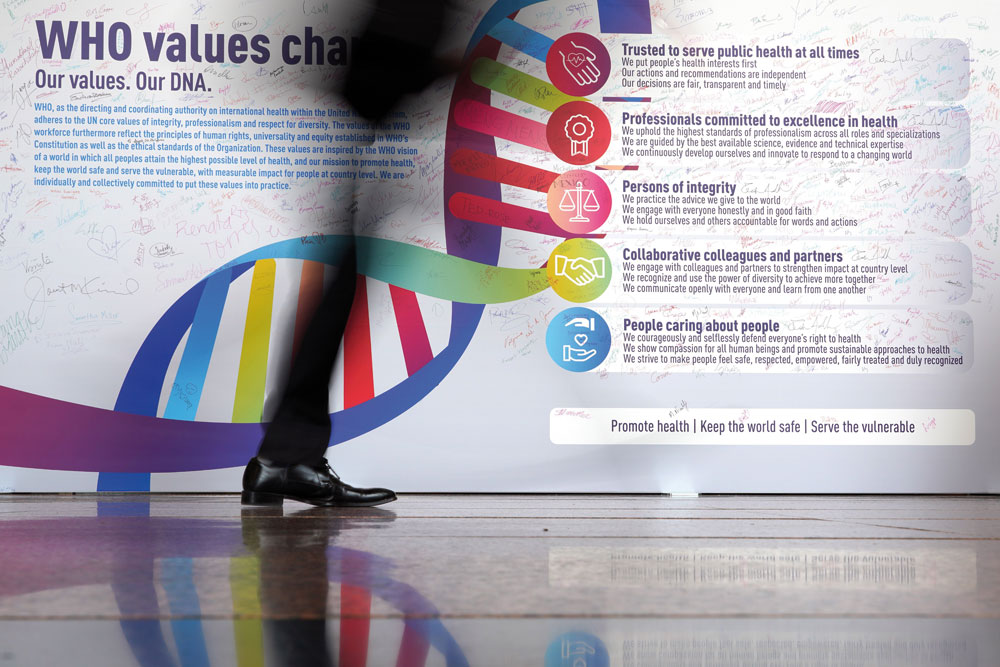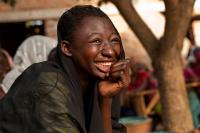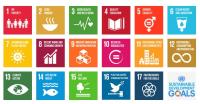A global debate

Could the different interests that have an impact on the World Health Organization have limited its ambitions?
In the 19th century, the worldwide trade of goods and merchandise from one place to another was increasingly growing. Along with trade came viruses, bacteria, and other undesired microorganisms. The fear of the propagation of diseases such as cholera, yellow fever, and the bubonic plague informed the beginning of the global cooperation in health, which has as its landmark the first international sanitary conference, which took place in Paris, in 1851, with the aim of establishing rules for quarantines, which was the name given to the period of isolation to which individuals, animals, and the foreign products that came from ports around the globe were submitted.
It may come as a surprise, but the history of global health is directly and indirectly connected to Brazil. In 1870, the country went through a huge yellow fever epidemic. Neighboring nations such as Paraguay, Uruguay, and Argentina were also affected. The disease spread throughout the continent, delaying the end of the construction of the Panama Canal for more than ten years. Along with malaria, yellow fever took the lives of more than twenty thousand workers, which made France abandon the project. The United States, however, had a great interest in seeing the completion of the works. It was in this context that the region of the Americas created, in 1902, the first sanitary office that the world had ever seen, which was called the Pan American Health Organization (PAHO).
Later on, Brazil would play a prominent role in this story. In 1945, the Brazilian delegation got together with the Chinese representatives to propose the creation of an international organization for health within the context of the creation of the United Nations (UN). ‘After World War II, there was a growing feeling that, to strengthen international solidarity regarding a fundamental topic—health—, the different institutions that acted on this field should be integrated. The aim of this was to ensure that there would be an ability to respond to sanitary emergencies, and also to ensure a certain pattern for the health policies, through an institution that had the technical ability to create norms and guidelines that would be valid for every government in the world,’ contextualizes Susana Barria, the person responsible for the global governance of the People’s Health Movement (PHM).
On April 7th, 1948, the World Health Organization (WHO) was created, which incorporated innovative principles. In its Constitution, health is understood as ‘a state of complete physical, mental, and social well-being, and not merely the absence of disease or infirmity.’ Moreover, ‘the highest attainable standard of health’ is listed as ‘one of the fundamental rights of every human being,’ which should be put into effect without any distinction of race, religion, political belief, economic or social conditions. Still, according to the text, the achievement of any State in the promotion and protection of the health of its inhabitants is an advance for every other country. Likewise, unequal progress in the achievement of this goal is a danger not only to those nations which lag, but to every nation. And health is understood as a fundamental condition to keep the peace. ‘The WHO originated from the understanding that health is a common good. And that guaranteeing health is good not only to one individual, their family, their community or society; it is good on a global scale,’ says Susana.
Even though the WHO has only one goal—to reach the highest level of health possible for all peoples—, its mission is extensive. ‘Most organizations have to deal with 1 or 2 attributions, but the WHO has 22 functions,’ states Andrew Harmer, Global Health Policy professor at the Queen Mary University of London. This is because the WHO has the authority to direct and coordinate the work in health on an international level. Whenever requested, the WHO must assist governments in strengthening health services, as well as in the case of sanitary emergencies. It should also work towards the eradication of epidemics, endemics, and diseases. And promote a good deal of cooperation, be it with other UN agencies in a large number of topics—housing, sanitation, recreation, and economic and working conditions are some of them—, or with scientific groups. The role of the WHO also includes proposing conventions, agreements, and regulations, and making recommendations. There is an intense work of standardization: of the nomenclature of diseases, public health practices, diagnostic procedures, food, and biological and pharmaceutical products. ‘The WHO guides how health policies should be developed. And it is an organization that bases a lot of its work on the expert recommendations. It has the power to join together different opinions and look for consensus regarding matters that are important on a global scale,’ explains Mariângela Simões, Assistant Director-General of pre-qualification and evaluation of the WHO. She also states that ‘It is written in the Constitution of the WHO what the Organization must do. But who determines what the Organization will do is the Assembly.’
The highest organ
The WHO is composed of three organs. The Secretariat is the operational arm of the Organization, and it is headed by a Director-General who is elected every five years. At the governance level, there is the Executive Committee, which is composed of 34 representatives of the Member States that integrate the WHO. This group, which meets twice a year, is charged with deciding which topics will be deliberated at the highest organ of government of the Organization: the World Health Assembly (WHA). In June 1948, the first Assembly was held. At that time, 48 countries integrated the WHO; 46 of them took part in the event. Today, there are 194 Member States, which are divided administratively into 6 sanitary regions: Africa, the Americas, Southeast Asia, Europe, Eastern Mediterranean, and Western Pacific. The WHO has over 7 thousand employees, which are spread throughout 150 national offices.
‘The WHO is a multilateral organization. Every country has a voice. This is one of its strengths, but also one of its weaknesses. An important issue may not be approved because a country has a contrary opinion. Therefore, the topics come and go,’ states Mariângela. An example of this is the destruction of smallpox virus stocks, one of the oldest issues in the Assembly’s agenda, which was first debated in 1980, when the disease was officially eradicated.
In 2019, between May 20th and 28th, the 72nd WHA was held. And, once again, this topic was discussed. Today, two public laboratories have samples of the virus: the State Research Center of Virology and Biotechnology VECTOR, in Russia, and the Centers for Disease Control and Prevention (CDC), in the United States. Both countries had committed destroying the stocks after the virus’ genome had been sequenced. This took place in 1996, but the US and Russia did not fulfill this commitment. The deadline was extended to 1999. But, once again, both countries refused to implement this resolution, arguing that the samples were needed to further the research. A special committee was created to supervise this research, and later, an independent committee was created to reevaluate all of the work. In 2013, new diagnoses had been created, a new generation of vaccines had been developed, and the independent committee concluded that there was no longer any public health purpose in keeping the stocks – which even then were not destroyed, for new arguments were presented, this time concerning the threat that the molecules of the virus had been synthesized as a way of developing a biological weapon. Many countries point to the fact that, had the stocks been destroyed in the past, such a threat would not have arisen. But, to this day, these arguments have been presented with no practical effect.
Geopolitics also manifests itself in other ways. ‘Sometimes – many times – due to commercial interests,’ states Mariângela. And 2019 is a great example of this kind of clash. In February, Italy presented a resolution proposal regarding transparency in the market for medicines, vaccines, and health technologies. One of its core ideas was to force companies to disclose all of the costs throughout the production chain, which include stages such as research and development, clinical trials, and marketing. Thus, it would be possible to know how much of the price of these products involves the research stage (as the industry advocates) or publicity and the maximization of the profits paid to the shareholders of these companies (as the specialists on the subject argue).
The proposal was co-sponsored by other European nations—Spain and Portugal—, and it quickly became the most pressing topic on the agenda, even before the Assembly began. In the two meetings that preceded the 72nd WHA, it became clear that the countries where the big pharmaceutical companies have their headquarters, such as Germany, France, the United Kingdom, and Switzerland, would use all of the necessary diplomatic means to prevent this kind of transparency proposed in the resolution. The UK delegation proposed editing the text to suppress from it any mention to ‘high prices,’ which was basically the core of the problem. The debate among the delegations, which was held behind closed doors, was extended throughout the whole event. More countries joined the proposal, which was the case of Brazil.
Even so, at a certain point, there was no certainty whether or not the resolution would be formally discussed by the Assembly. And an aura of apprehension took over the Palace of Nations, where the event is held, in the city of Geneva, Switzerland, when, at the backstage, there were indications that the text could be completely altered. The risk was that the political moment generated by the resolution would turn out to be an anticlimax, since a bad decision could hinder future discussions, and, consequently, further advances. At the last moment, the resolution was presented for voting, and it passed. But the approved text is far less ambitious than the original: the whole section regarding transparency in the production chain was removed.
Rise and fall
Many consider that the peak of the political ambitions of the WHO took place long ago. If the idea of ‘health for everyone’ is inscribed in the very Constitution of the Organization, this goal was never as evident as it was at the end of the 1970s. Under the leadership of Halfdan Mahler—who was considered by many the most capable Director-General that the WHO has ever had—, in 1978, in Kazakhstan, then a Soviet republic, the International Conference on Primary Health Care was held. This Conference resulted in the famous Declaration of Alma-Ata, with the motto ‘health for all the peoples of the world by the year 2000.’ At that time, the WHO put faith on a goal so that its main objective would be fulfilled. And the Organization did that using a convincing language.
‘The existing gross inequality in the health status of the people, particularly between developed and developing countries as well as within countries, is politically, socially, and economically unacceptable and is, therefore, of common concern to all countries,’ states the document, which defended the establishment of a ‘New International Economic Order’ as the fulcrum for the accomplishment of ‘health for all the peoples of the world.’
‘It was a very particular context. After the anticolonial struggles, governments are seeking to establish different relationships among themselves during the Cold War. And one of the main topics is the new international economic order. This kind of understanding is related to a desire of transforming the power relationships. And the United Nations is seen as a space in which differences can be neutralized because everyone has a vote. The vote of a small country carries the same weight as that of a huge country. The vote of a country with a high GDP carries the same weight as that of the country with the lowest GDP,’ analyzes Susana Barria, to whom the Declaration of Alma-Ata became a symbol of the potential of the UN System, and is an inspiration to this day. ‘The text relates the human right to health with the arrival of this new economic order. It puts the needs of the people at its center, and opposes the mercantilization of health,’ she states.
The reaction would soon come. If Alma-Ata spoke of the importance of strong health systems based on robust primary health care, which, through prevention and promotion, could avoid a series of illnesses, in the following decade a different logic prevailed, with the so-called focus on primary health care and the vertical approach geared towards a response to certain illnesses. Different actors came into play. ‘Ever since 1980, the World Bank started acting in health. In 1993, it produced a highly influential report entitled “Investing in Health,” which placed the private sector in the foreground, shaping how health would be understood from then on,’ says Andrew Harmer.
Later on, a series of initiatives connected to entrepreneurs came to be. In 2000, Bill Gates, who, at that time, was the richest man in the world, stepped down as Microsoft CEO and established a philanthropy foundation called Bill & Melinda Gates. His interest in health went beyond that very same initiative, and, in the same year, he donated US$ 750 million to a fund for vaccines that, soon after, would attract other donors and result in the creation of the Global Alliance for Vaccines and Immunization (GAVI, which is currently called the GAVI Alliance). The Global Fund to Fight AIDS, Tuberculosis, and Malaria was also created in 2000. ‘The initial idea was that it would be a much broader global fund for health. But that never happened,’ recalls Harmer. The focus on a single disease also mobilized the President of the United States to create, in 2003, the multi-billion dollar United States President’s Emergency Plan for AIDs Relief (PEPFAR). And these are just a few examples.
‘Then, the question became: what is the political relevance of the WHO if we have other initiatives that are very important?’, says Harmer, to whom the Organization needed to implement a strategy to defend its space amidst an increasingly complex architecture of the global health governance. Under the leadership of the former Norwegian Prime Minister, Gro Brundtland, who was Director-General of the WHO between 1998 and 2003, the organization adopted the model of partnerships with these rising actors. ‘It was an essentially political decision. Brundtland feared that the WHO would be marginalized. And she decided to place it at the core of all of these partnerships – including harboring many of them in its headquarters, in Geneva,’ she points out.
At the same time, the 1990s marked the beginning of a severe crisis in funding that goes on till the present day. ‘The countries agreed to freeze their contributions to the WHO. Not entirely at first, since the sums of the funding were corrected for inflation. But this was also suspended. So, in truth, the contributions decreased because they did not follow inflation,’ explains Harmer.
According to the people interviewed by the Poli journal, the argument used by the Member States is that the WHO is neither efficient nor effective. That is, the money that the countries are ‘investing’ in the Organization is not rendering returns. Following this logic, the Organization should do more with less. ‘There is a political agenda hidden behind this discourse: to drive the attention and the narrative away from the central issue that the WHO needs more funding to fulfill its role as an organization that develops and may implement global health policies,’ analyzes Susana. ‘We observe a search for deficiencies—which is a market term—and the cut in funding in low-priority areas. The problem lies in defining which areas could be categorized as being of low priority, because one can argue that the health issues for which people care most are not necessarily those that are the most important to the donors,’ highlights, in turn, Harmer.
This is because the gap in funding from the Member States was now filled by voluntary contributions, which were made by countries and by philanthropic entities and companies. In 2017, a contribution made by the Bill & Melinda Gates Foundation represented an astounding 13% of the general budget of the WHO. To get an idea of this shift, in the 1950s and 1960s, the budget of the WHO was comprised of 70% of contributions from the Member States and of 30% of voluntary contributions. Nowadays, this ratio has been inverted.
The problem with voluntary contributions is that, in many cases, the donors determine exactly where and how the resources will be applied. And this has raised a series of concerns regarding the direction of the course of action of the WHO. ‘What is becoming clear is that the Gates money is not restricted to the WHO; it extends to many organizations. All of the actors that Gates funds are becoming part of the “family” of the WHO. Indirectly, Gates is everywhere. And he brings with himself a private-sector perspective and mentality. He interprets health in terms of results and impact because he is guided by money. The only way for him to understand success is through a spreadsheet, in which a reduction or increase in some unit of value is demonstrated. But this is not the only way in which societies progress. There are many structural and systemic challenges, none of which can be solved by Gates and by the way he operates. He is probably part of the problem,’ criticizes Harmer.
‘I think there is a great deal of fantasy regarding this, do you know?’, refutes Mariângela Simões, who gives us an example a plan of action geared towards the vigilance of new medicines after they are released in the market. ‘The funders are interested in this regulatory agenda, and so are we. That is part of a set of things that the WHO wants to do—because it is never something that we do not want to do. A system that can achieve that is good for the world. And if there is money from the Gates [foundation], let it come. But things have to connect. You do not take money that is not destined to an interesting area,’ she ponders.
‘Our new approach regarding the partnerships is helping to let us turn from an organization that opposes risk to one that can manage risks. That is not a slogan; it is a change of course. We are already becoming engaged in a much more proactive way with the civil society organizations and the private sector,’ said Director-General Tedros Adhanom Ghebreyesus at the opening of the 72nd WHA. To Mariângela Simões, the rules of the Organization are also working to avoid problems. ‘The WHO has a very large firewall system regarding the issue of conflicting interests,’ she states.
She refers to the framework of engagement with non-State actors (FENSA). However, the text approved in 2016 is already being disrespected, in the evaluation of certain analysts. That is because the FENSA prohibits commercial exhibitions during WHO events. But, in the 2019 WHA, Unaids, the joint United Nations program on HIV and AIDS, launched an exhibition called ‘Health Innovation Exchange.’ Among the 24 ‘innovations’ showcased in the exhibition, there was an ad for a diagnosis program created by pharmaceutical company Roche, and ad for an auto-retractable needle syringe, an ad for a device used in circumcision procedures… Physician Gargeya Telakapalli, who is a member of the People’s Health Movement Global Secretariat, believes that the exhibition has violated the rules of the FENSA. ‘This is a landmark. I have spoken to a long-time WHO official, and he told me that he had never thought that something like this could ever happen. But now it has. This was a clear violation of the FENSA.’ Both the movement and the Third World Network (TWN) organization demanded explanations. ‘We hoped that the WHO and UNAIDS would at least provide some kind of answer or justification, but that did not happen,’ he regrets.
In January 2019, the list of non-State actors that had formal relationships with the WHO had 217 organizations, such as international federations that represent the pharmaceutical industry, societies, and associations of health professionals and medical specialties, entities that represent patients and students, large philanthropic foundations, and civil society organizations. ‘Academia, civil, society, donators and what is the private sector got mixed; those are actors who have different roles and interests. Putting them together is a strategy to legitimize and ensure formal spaces so that the private sector can collaborate with the WHO. And the same thing is happening in other UN organizations,’ believes Susana.
To Andrew Harmer, it is an increasingly biomedical environment, guided by innovation, data collection, and the cost-benefit logic. According to him, the consequence of that is the emergence of a ‘monoculture’ regarding what is health and how health issues should be solved, amidst which it is ever more difficult for alternative voices to be heard.
But those voices are there. There are doubts, however, concerning the efficacy of the civil society engagement in the WHA and WHO today. To Maurício Torres-Tovar, a member of the Latin American Social Medicine Association (ALAMES), there are problems. ‘We were present and tried to influence things. But our capability is far lower than that of the pharmaceutical industry, for example.’ Torres-Tovar points out that the loss of centrality of the WHO itself has limited the ambition of the Organization’s proposals. And, as an example, he mentions universal health coverage, the main issue currently championed by the Organization, with its ‘ triple billion’ goals: 1 billion more people benefitting from universal health coverage, 1 billion more people better protected from health emergencies, and 1 billion more people enjoying better health and well-being. “This huge policy, which imposes itself on the world today, is an idea that has been going on for years, which has been divulged by the World Bank, the Rockefeller Foundation, as well as other entities. The WHO went along with them on this issue. The Organization was carted along with it,’ he analyzes.
In contrast, the Alma-Ata wished for more. ‘Today, advocating for health for all is revolutionary,’ compares Susana. To Andrew Harmer, even with all of the difficulties, the WHO could take on the lead regarding difficult issues, such as global warming. ‘I wish the Organization were more ambitious regarding the message it conveys to its Member States, and regarding the visibility, it provides to certain health issues, particularly the climate issue,’ he mentions. And defends that “There is room to be a bit bolder.’



